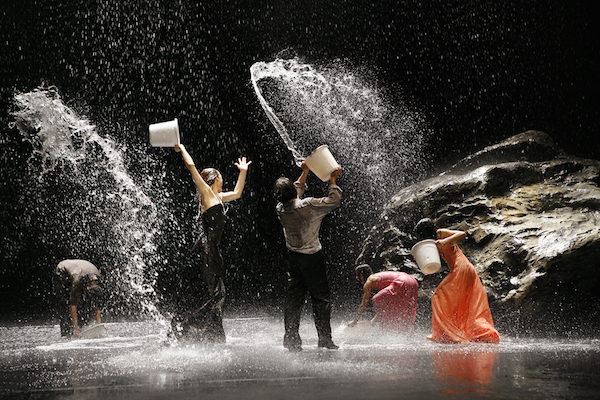
Aufführung des Pina Bausch-Stücks „Vollmond”, Wuppertal, Mai 2006 Fotografie © Laurent Philippe
For Italian version please scroll down
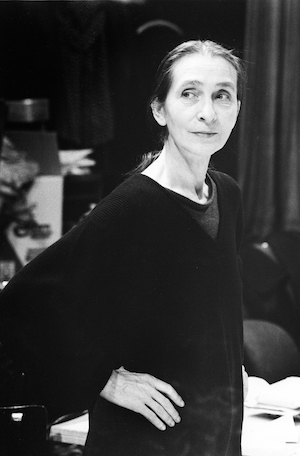
Porträt Pina Bausch
Foto: Wilfried Krüger
© Pina Bausch Foundation
Just think of Isadora Duncan (1877 – 1927), the forerunner of modern dance, who, freed from pointe shoes – introduced by Filippo Taglioni in 183 -, she began to perform in unusual places, barefoot and wearing soft dresses that would allow her body to make supple movements. Or Ruth St. Denis (1879 – 1968), famous for her mystic and oriental inspired dance. And then again, think of Martha Graham (1894 – 1991) from the United States, who is considered – along with Doris Humphrey – the mother of modern dance, with her technique contraction and release, who instead of trying to make her dancers fly, she made them human and grounded. In Europe, among the many prominent personalities who have significantly contributed to the evolution of the dance, Rudolf Laban (1879 – 1958), creator of the method of the steps notation, known as labanotation, or Pina Bausch (1940 – 2009) who is known for her unforgettable Tanztheater (dance theater), are both worth mentioning.
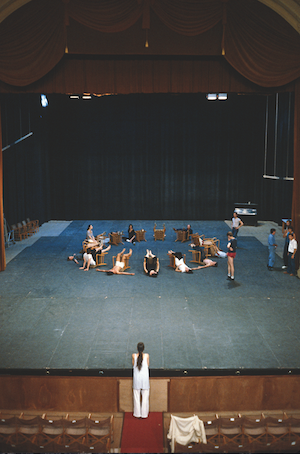
Foto: Ulli Weiss Bühhnenprobe zu Nelken-Teatro Malibran venedig
1983 Pina Bausch Foundation
For a dancer, they are not only mythical figures, but also fundamental references for the study of movement and its evolution, for understanding the use of space and of different levels. More generally, they are essential in order to appreciate and recognize, throughout different historical periods, the changes in forms of expression and use of the body.
I still remember the excitement I felt when I was in Rome and saw Split Sides by Merce Cunningham (1919 – 2009), a choreographer who is among the greatest exponents of Post-modern dance; or when I attended a performance by the Trisha Brown Company as a guest at the Aqui Terme dance competition where I participated with the Performing Arts Group of Gabriella Stazio and came in third place; or my first dance class with Joseph Fontano, who is – together with Elsa Piperno – the pioneer of contemporary dance in Italy.
So you can easily imagine my enthusiasm at the news that from September 16th until January 9th 2017, it was going to be possible to see the Pina Bausch und das Tanztheater at Martin Gropius Bau.
Pina Bausch und das Tanztheater
I went to see the exhibition this week. Following the photographic journey, watching the many videos and reading documents and choreographic records on sheets of paper and notebooks displayed in glass cases, you can retrace the professional life of the dancer/choreographer from Wuppertal. The first images depict a Pina Bausch who, still very young, was studying with Kurt Joos at Folkwangschule Essen. Then there are images from the early sixties when she attended the Juilliard School of Music in New York. The videos of her first performances and the photographs of the classes which she attended were very interesting. It was remarkable how from the beginning of her career her face was very expressive. Following on there are images and videos of the period when she was back in Germany and became a soloist at the Folkwang-Ballett then later on the director of the Wuppertal dance company, all the way up to the birth of the Tanztheater in 1973. The projections of her work, which reveal the influence of German expressionism, are truly hypnotic and demonstrate how her creative processes were genuinely innovative.
The stage is no longer the ‚other‘ place separate from reality in which dancers twirl in the air or try to define the space with movement; it becomes a representation of everyday life.
Set designs are places where real life is lived, where the dancers are no longer dancers, but men and women moved by emotions, characters and stories of lives lived.
The Lichtburg
For the occasion, the museum also rebuilt the Lichtburg, which was the rehearsal room without any windows (built inside an old cinema); the birthplace of most of the best known pieces by Pina Bausch.
In this spot, during my visit to the exhibition, some of the Company members held short lectures or workshops which you could take part in. You can attend a show, participate in the talk, or watch videos that are projected on the walls.
For lovers of dance and art in general, for the curious or those who want to be swept up in this process of dance and emotions, this exhibition is not to be missed.
PINA BAUSCH UND DAS TANZTHEATER
16. September 2016 bis 9. Januar 2017 in Berlin im Martin-Gropius Bau.
ITALIAN VERSION
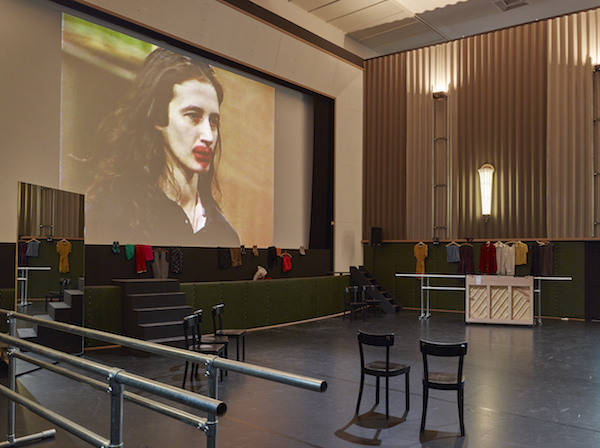
Ausstellungsansicht, Foto: Simon Vogel, 2016 © Kunst- und Ausstellungshalle der Bundesrepublik Deutschland GmbH
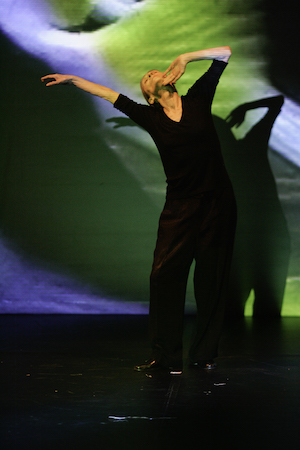
Foto: Jochen Viehoff
Pina Bausch tanzt ein Solo in Danzón (Ausschnitt)
Fotografie
© Jochen Viehoff
Si pensi a Isadora Duncan (1877 – 1927), antesignana della danza moderna, la quale, liberatasi dalle scarpette a punta introdotte da Filippo Taglioni nel 1832, iniziò a esibirsi in luoghi atipici, a piedi nudi e con abiti morbidi tali da consentirle movimenti flessuosi del corpo. Oppure a Ruth St. Denis (1879 – 1968), famosa per la sua danza mistica e d’ispirazione orientaleggiante. Ed ancora, sempre negli Stati Uniti, si pensi a Martha Graham (1894 – 1991), la quale, considerata – insieme a Doris Humphrey – la madre della danza moderna, con la sua tecnica contraction and release, invece di far volare i suoi ballerini, cercò di renderli “umani” e terreni. In Europa, tra i tanti personaggi di rilievo che hanno contribuito in modo significativo all’evoluzione della danza, basta citare Rudolf Laban (1879 – 1958), creatore del metodo di annotazione dei passi, conosciuto come labanotation, o Pina Bausch (1940 – 2009) indimenticabile per il suo Tanztheater (teatro-danza).
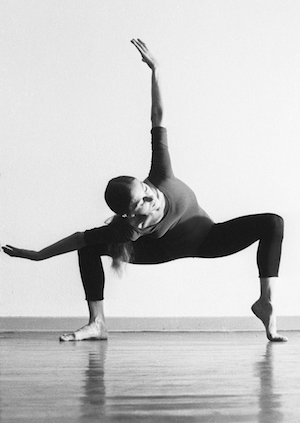
Foto: Rolf Borzik
Probe: Im Wind der Zeit
Choreografie: Pina Bausch
Folkwang Hochschule Essen, 1969
© Pina Bausch Foundation
Per un danzatore, non solo dei miti, ma dei riferimenti fondamentali per lo studio del movimento e della sua evoluzione, per la comprensione dell’utilizzo dello spazio, dei livelli e, più in generale indispensabili per apprezzare e riconoscere, nei diversi periodi storici, i cambiamenti delle forme espressive e dell’utilizzo del corpo.
Ricordo ancora l’emozione che provai quando vidi a Roma Split Sides di Merce Cunningam (1919 – 2009), coreografo tra i maggiori esponenti della post modern dance; oppure quando ho assistito alla performance della Trisha Brown Company, ospite al concorso di danza Aqui Terme al quale, partecipando con il Performing Arts Group di Gabriella Stazio, ci classificammo terzi; o alla mia prima lezione con Joseph Fontano, pioniere, con Elsa Piperno, della danza contemporanea in Italia.
Facile immaginare, quindi, l’entusiasmo alla notizia che dal 16 settembre presso il Martin Gropius Bau e fino al 9 gennaio 2017, sarebbe stato possibile visitare la mostra Pina Bausch und das Tanztheater.
Pina Bausch und das Tanztheater
In settimana ho visitato la mostra.
Seguendo il percorso fotografico, guardando i numerosi video e leggendo documenti e annotazioni coreografiche sui fogli e i quaderni esposti nelle teche, è possibile ripercorrere la vita professionale della danzatrice-coreografa di Wuppertal.
Le prime immagini ritraggono una Pina Bausch quando ancora giovanissima studiava con Kurt Joos alla Folkwangschule di Essen e, nei primi anni sessanta, presso la Juilliard School of Music di New York.
Molto interessanti i video delle sue prime esibizioni e le fotografie delle classi cui partecipava. Singolare come, sin dall’inizio della sua carriera, il suo viso fosse estremamente espressivo.
Seguono immagini e video del periodo in cui, tornata in Germania, prima divenne solista al Folkwang-Ballett e poi direttrice del corpo di ballo di Wuppertal, fino ad arrivare alla nascita del Tanztheater nel 1973.
Ipnotiche le proiezioni delle sue opere dalle quali emerge l’influenza dell’espressionismo tedesco, e che testimoniano come i suoi processi creativi fossero assolutamente innovativi.
Il palcoscenico non è più il luogo ‘altro’ dalla realtà, in cui i ballerini volteggiano nell’aria o cercano di definire lo spazio con il movimento, ma diventa una rappresentazione della quotidianità. Scenografie e allestimenti sono luoghi di vita vissuta, e gli stessi danzatori non sono più ballerini, ma uomini e donne mossi da emozioni, personaggi di storie e di vite vissute.
La Lichtburg
Per l’occasione è stata anche ricostruita la Lichtburg, la sala prove senza finestre (ricavata all’interno di un vecchio cinema), dove sono nati la maggior parte dei pezzi più noti di Pina Bausch.
Qui, durante la vista alla mostra, alcuni membri della compagnia tengono brevi lezioni o laboratori a cui si può liberamente prendere parte, è possibile assistere a qualche spettacolo, partecipare a dei talk, o guardare i video che sono proiettai.
Per gli amanti della danza o dell’arte in generale, per i curiosi o per chi vuole lasciarsi accompagnare in questo percorso di danza e di emozioni, la mostra è assolutamente da non perdere.
PINA BAUSCH UND DAS TANZTHEATER
16. September 2016 bis 9. Januar 2017 in Berlin im Martin-Gropius Bau.
